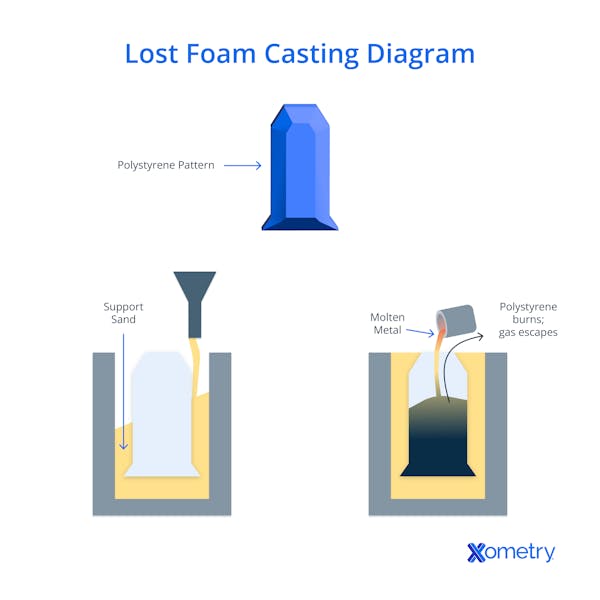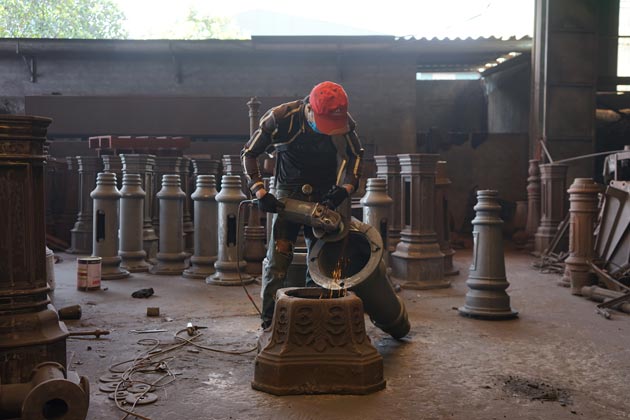Exactly How Aluminum Foundry Adds to Innovations in Aerospace Design
Aluminum factories are indispensable to advancements in aerospace engineering. They generate light-weight, high-strength components that are important for contemporary airplane. With innovative spreading strategies, these factories create intricate geometries that boost structural stability. Furthermore, the growth of remarkable Aluminum alloys sustains the sector's concentrate on fuel effectiveness and sustainability. However, difficulties stay in the manufacturing procedure. Understanding these elements reveals the profound impact of Aluminum on aeronautics's future.
The Importance of Lightweight Materials in Aerospace Design
As the aerospace market remains to advance, the value of lightweight materials comes to be significantly obvious. The need for efficiency and sustainability drives engineers to prioritize using materials that reduce overall weight without jeopardizing architectural honesty. Light-weight products, especially Aluminum, play a vital duty in boosting gas effectiveness, boosting haul capability, and enhancing the general performance of airplane.
Moreover, the integration of these materials enables for ingenious designs, allowing manufacturers to create more wind resistant shapes that can stand up to severe problems. The decrease in weight not only reduces functional costs yet also adds to a lowered ecological impact, straightening with international efforts toward sustainability in air travel.
Advanced Casting Techniques in Aluminum Foundries
Advanced spreading strategies in Aluminum foundries play a vital function in aerospace design by making it possible for the production of light-weight and accurate elements. Technologies in mold style and accuracy spreading procedures are crucial in accomplishing optimal efficiency and architectural honesty. Furthermore, the advancement of light-weight alloys boosts the general performance and effectiveness of aerospace applications.
Innovative Mold And Mildew Style
Innovative mold and mildew layout plays a vital duty in the performance and efficiency of Aluminum factories, especially within the aerospace sector. By leveraging sophisticated products and techniques, contemporary molds can be engineered to hold up against heats and stress, guaranteeing peak efficiency during the spreading procedure. These designs commonly integrate complex geometries that enable for the manufacturing of lightweight yet structurally audio components, crucial for aerospace applications. Furthermore, using computer-aided layout (CAD) software helps with accurate modeling, enabling factories to improve and imitate mold and mildew layouts before physical manufacturing begins. This not just enhances the quality of actors parts but additionally minimizes waste and lead times, bring about substantial expense savings. Overall, innovative mold and mildew style is a cornerstone of progress in Aluminum Foundry modern technology for aerospace design.
Precision Casting Processes
The performance of cutting-edge mold and mildew designs effortlessly incorporates with accuracy casting procedures, which are vital for creating top notch Aluminum elements in aerospace engineering. These processes, consisting of sand spreading, die casting, and investment casting, ensure the creation of complex geometries with tight resistances. Advanced strategies like vacuum spreading and pressure die casting boost the integrity and surface coating of the last items. Accuracy casting decreases material waste while maximizing the mechanical residential or commercial properties of Aluminum, crucial for aerospace applications. Furthermore, using real-time tracking and advanced simulation tools throughout the casting process permits instant adjustments, leading to improved high quality control. Collectively, these precision spreading processes setting Aluminum shops at the center of aerospace technology, sustaining the sector's demand for integrity and efficiency.
Lightweight Alloy Development
As aerospace engineers look for to improve fuel effectiveness and efficiency, lightweight alloy development ends up being a necessary emphasis in Aluminum foundries. These foundries use advanced casting methods to create alloys that supply remarkable strength-to-weight ratios. Advancements in alloy structure, consisting of the unification of aspects like lithium and magnesium, make it possible for the manufacturing of products that stand up to extreme conditions while decreasing total airplane weight. Techniques such as die spreading and financial investment casting facilitate the precision production of complicated shapes, which are vital for aerospace applications. Additionally, recurring study aims to maximize these alloys for boosted mechanical properties and increased sturdiness. By focusing on lightweight alloy development, Aluminum factories considerably contribute to the development of aerospace engineering, leading the way for extra sustainable and efficient aircraft designs.

Enhancing Structural Honesty Through Aluminum Parts
Aluminum parts provide substantial benefits in boosting architectural stability within aerospace engineering. Their lightweight nature adds to general effectiveness while maintaining toughness, which is crucial for aircraft performance. In addition, the stress and anxiety resistance homes of Aluminum help guarantee the durability and integrity of aerospace structures under different operational problems.
Lightweight Material Benefits
While conventional products commonly jeopardize weight for stamina, making use of Aluminum elements in aerospace design supplies substantial advantages in structural stability. Aluminum's lightweight nature adds to overall design performance, enabling for even more structured airplane that take in much less fuel, thereby enhancing sustainability. The material's superb strength-to-weight ratio assurances that parts preserve durability without including unneeded mass. This high quality promotes enhanced efficiency and dexterity in flight, in addition to maximized payload capabilities. Furthermore, Aluminum's resistance to rust extends the life expectancy of aerospace frameworks, reducing maintenance costs and boosting safety. As suppliers progressively embrace Aluminum alloys, the aerospace sector experiences a transformative change towards extra effective and efficient engineering options that focus on both efficiency and environmental duty.
Anxiety Resistance Qualities
Numerous materials possess distinct homes, Aluminum's remarkable stress and anxiety resistance stands out as an essential aspect in enhancing the structural stability of aerospace elements. This resistance plays a critical function in making sure that aircraft can withstand various operational anxieties, including exhaustion, effect, and environmental problems. Aluminum alloys, specifically crafted for aerospace applications, display high tensile stamina while keeping lightweight features, enabling designers to design much more effective frameworks - Aluminum Foundry. In addition, the capability of Aluminum to withstand cyclic loading without considerable deformation adds to the longevity and integrity of aerospace components. As developments continue in Aluminum Foundry strategies, the growth of stress-resistant Aluminum parts guarantees further renovations in efficiency, safety, and performance throughout the aerospace market, strengthening Aluminum's function as a recommended product in modern-day design
Fuel Efficiency Improvements Driven by Aluminum Innovations
As the aerospace market seeks to improve gas efficiency, ingenious uses of Aluminum have actually emerged as a necessary solution. Aluminum's light-weight nature especially minimizes airplane weight, enabling for reduced fuel usage throughout trip. This decrease in weight is important, as even small decreases can result in substantial enhancements in general gas economy.
Advanced Aluminum alloys, designed for enhanced toughness and resilience, enable manufacturers to produce parts that maintain structural honesty while decreasing mass - Aluminum Foundry. Additionally, the assimilation of Aluminum in airframes and engine components assists in enhanced the rules of aerodynamics, adding to minimized drag and boosted effectiveness
The adoption of Aluminum in aerospace not just fulfills the need for fuel-efficient design but additionally aligns with regulatory stress for lower emissions. As these innovations remain to develop, they play a significant duty in setting brand-new benchmarks for gas effectiveness, making certain that the aerospace field can fulfill expanding financial and environmental obstacles.

The Role of Aluminum in Sustainable Aeronautics Practices
The increasing focus on sustainable aviation techniques has placed Aluminum as an important product in the pursuit for greener airplane style. Recognized for its lightweight properties, Aluminum substantially minimizes aircraft weight, leading to reduced fuel intake and discharges. Its recyclability better boosts its sustainability account, as Aluminum can be recycled indefinitely without loss of top quality. This particular supports a circular economy within the air travel industry, decreasing waste and source depletion.
Advancements in Aluminum alloys have actually improved their strength and deterioration resistance, enabling for longer service life and lowered upkeep needs. These developments facilitate the advancement of extra efficient airplane structures, adding to general sustainability initiatives. Furthermore, Aluminum's thermal conductivity plays a click this site critical role in energy-efficient styles, boosting systems such as warmth exchangers. Collectively, these attributes emphasize Aluminum's pivotal role beforehand lasting aviation, lining up with global initiatives targeted at reducing the environmental impact of air traveling.
Difficulties Dealt With by Aluminum Foundries in Aerospace Manufacturing
While Aluminum shops play an important function in aerospace production, they face significant difficulties that can influence manufacturing efficiency and top quality. One significant challenge is the stringent top quality control standards required in the aerospace sector. Any defect can jeopardize safety and efficiency, requiring rigorous examination procedures that extend production timelines. Furthermore, foundries commonly emulate changing basic material costs, which can affect rates and success. The complexity of Aluminum alloys made use of in aerospace applications additional makes complex the production process, as accurate solutions are important for achieving wanted mechanical residential or commercial properties. Additionally, skilled labor lacks impede the capacity to maintain high-quality manufacturing degrees. Ecological policies enforce constraints on discharges and waste administration, calling for factories to spend in lasting methods, which can be cost-prohibitive. These aspects collectively produce a landscape where Aluminum factories must continuously adapt to fulfill the developing needs of aerospace manufacturing while ensuring safety and security and conformity.
Future Patterns in Aluminum Applications for Aerospace Engineering
With developments in technology and boosting needs for efficiency, the future of Aluminum applications in aerospace design is poised for substantial change. The integration of cutting-edge Aluminum alloys and compounds is expected to improve strength-to-weight proportions, leading to more fuel-efficient airplane layouts. Furthermore, advancements in additive manufacturing methods will permit for the production of intricate Aluminum frameworks that were previously impossible, maximizing performance and reducing waste.

Sustainable methods will certainly play a vital role, with a growing emphasis on recycling Aluminum to minimize environmental effect. The aerospace field is most likely to embrace smarter manufacturing processes, such as automation and expert system, making sure higher quality and accuracy in Aluminum parts. In addition, partnerships in between Aluminum shops and aerospace companies will promote study and growth, leading the way for brand-new applications that fulfill the stringent requirements of contemporary aerospace design - Aluminum Foundry. Overall, the future looks guaranteeing for Aluminum's function in forming the skies
Regularly Asked Concerns
What Are the Ecological Influences of Aluminum Manufacturing in Aerospace?
The ecological impacts of Aluminum production in aerospace include substantial power consumption, greenhouse gas emissions, and habitat interruption. Additionally, mining procedures can bring about soil visit this website destruction and water contamination, increasing worries about sustainability and eco-friendly equilibrium.
Just How Does Aluminum Compare to Other Products in Aerospace Applications?
Aluminum provides a special combination of light-weight properties, deterioration resistance, and cost-effectiveness contrasted to other materials. Its high strength-to-weight ratio makes it particularly beneficial for aerospace applications, boosting gas efficiency and total performance in aircraft layout.
What Qualifications Do Aluminum Foundry Workers Requirement for Aerospace Projects?
Aluminum Foundry workers call for customized training in metallurgy and casting methods, in addition to knowledge of aerospace industry requirements. Certifications in high quality control and safety and security protocols are additionally important to guarantee conformity with strict aerospace task demands.
Are There Any Kind Of Safety Concerns With Utilizing Aluminum in Aerospace Design?
Safety worries relating to Aluminum in aerospace engineering consist of sensitivity to tiredness, rust, and stress cracks. Appropriate therapy and alloy selection are vital to mitigate these threats, making certain structural stability and overall safety in aerospace applications.
How Does Aluminum Recycling Benefit the Aerospace Sector?
Aluminum reusing substantially benefits the aerospace market by lowering product expenses, lessening environmental effect, and preserving power. This lasting technique enhances the market's performance while advertising using lightweight, high-performance elements in airplane production.
Advanced spreading techniques in Aluminum foundries play an essential duty in aerospace engineering by making it possible for the manufacturing of exact and light-weight parts. Innovative mold style plays an essential duty in the efficiency and effectiveness of Aluminum foundries, specifically within the aerospace market. As aerospace engineers seek to enhance fuel effectiveness and efficiency, light-weight alloy advancement comes to be a necessary focus in Aluminum foundries. Aluminum alloys, particularly crafted for aerospace applications, display high tensile strength while keeping lightweight attributes, enabling engineers to create extra efficient frameworks. Collaborations in go between Aluminum foundries and aerospace business will promote research study and advancement, paving the method for brand-new applications that meet the strict demands of contemporary aerospace design.